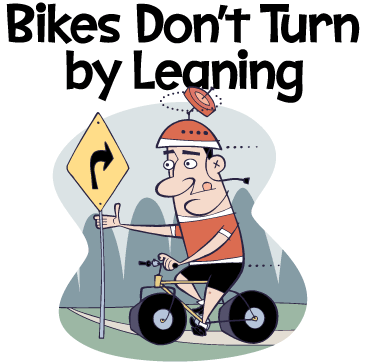

Can you turn a bicycle by leaning without turning the front wheel? Do bike tires tilted on their sides act like cones which turn your bike? Does your bicycle turn by gyroscopic precession ignoring you at the handlebars altogether with a snooty scientific demeanor?
The short answer to all these is, not on planet Earth. The long answer is the rest of this article. If you’re satisfied with short answers you are done. Stop thinking about it and go ride your bike and remember to keep turning the handlebars. The rest of you… prepare.
For clarity, or just because it’s my bit, these are the terms I’ll use. (Most of the time.) Something turning like the front wheel-fork-handlebar assembly, is rotating. Something leaning or tipping or just plain out of plumb is tilting. A wheel going round and round is spinning. Moving from one point to another is travelling. A wheel travelling is rolling. Unless it falls over or is going sideways and then it’s skidding. Travelling in a curved path is turning. Travelling in a zig-zag is taking evasive manuevers, but we need not concern ourselves with that.
One more point, everything that follows assumes a flat, level surface. Maybe with nice hedges on the sides and a chasm at one end just to make it dangerous and exciting.
We begin by looking at one thing everyone agrees with, how a fully upright bicycle works. First, rotate the front wheel 90 degrees. Next, push the front end rolling it forward. If all goes according to plan the front end turns in a circle and the back wheel rotates in place as a pivot point. (As in animation below)
Next, try this maneuver with the front wheel rotated 45 degrees. Roll it, the front wheel turns in a circle as before, the rear wheel trails behind in a smaller circle like a pimple-faced kid brother you just can’t shake. The rear wheel in this case is like a moving pivot point, a trailing pivot, a circling pivot, a pivot of the… you get the idea. The bicycle is turning by tracking. (Unless you’ve been holding it off the ground in which case it’s turning by toting. When bikes travel off the ground a whole different set of principles apply. Such as, if you don’t look down you won’t fall. This works in cartoons, anyway.)
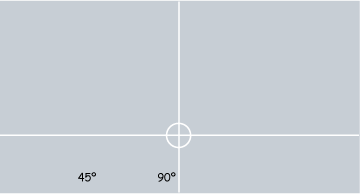

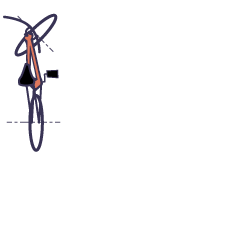
Click pic to play animation
Back to cases. Imagine removing the frame of the bike above left so there is just two wheels. Imagine each wheel rolling forward. What happens? Both travel straight, the front travels off at 45 degrees and the rear straight ahead, never to see each other again. Unless they meet on the other side of the world, which seems unlikely. Neither wheel turns. Compare a bike with a frame to two wheels without a frame below:
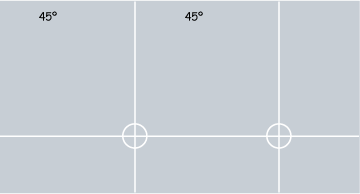

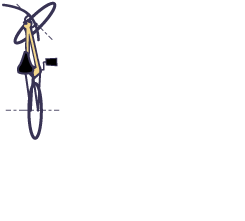
Click pic to play animation
Thing is, a bicycle is not just two wheels, it’s two wheels, one trailing the other desperate to keep up, connected by a frame. The two wheels of a bicycle cannot travel independently, they’re joined at the hip, so to speak. Wheels are like brats and a bike is like a nice, wholesome family, or close friends if you prefer. Which means what might make a single wheel turn, doesn’t work on a bicycle arrangement and vice-versa.
The frame does more than keep your butt from scraping the pavement, an altogether desireable thing, it makes a bike track. Even though they all travel on wheels, a unicycle is different than a bicycle which is different than a four-wheeled automobile with a trailer. If you’ve ever tried to back a boat into the water for launching you know what I mean. Comparing the differences is not like apples to oranges, more like an apple to a bunch of grapes.
Here’s something you may not have considered: imagine extending your wheel axles 20 feet. When you rotate the front end the extended front axle crosses the extended rear axle at the center of the turn. Without allowing the front end to rotate these two extended axles are parallel, they never meet no matter how much they tilt or make promises to do lunch. This means the front wheel leads the back straight ahead and the rear tracks directly behind, there is no turn at any tilt angle whether you like it or not.
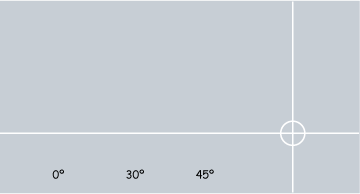

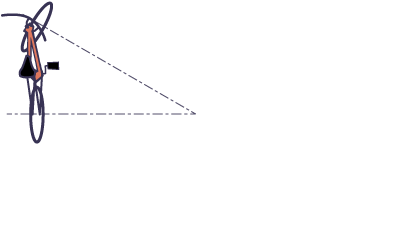
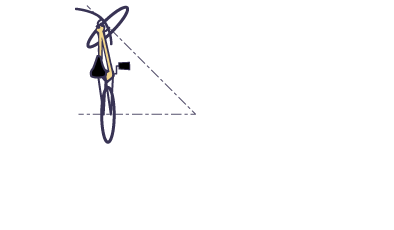
Click pic to play animation
A more technical explanation of tracking would be the rear wheel is a centripetal force on the front wheel pulling it into the turn. The front wheel moving to the side is a centripetal force on the rear rotating it into the turn. The two wheels each turning one another makes the bike turn where the axes of each cross.
The wheelbase of your bike effects handling. Some say a bike with a shorter wheelbase reacts quicker, is more responsive. That’s a fair description, but reaction time doesn’t really change. A 45 degree rotation of the front end gives you a wider turn on a bigger bike because the axes of the front and rear wheel cross further away. This makes longer radii, and a bigger circle. So big the longer bike has trouble staying in the frame. To turn in the same circle as a small bike you have to rotate the front end more on a big bike. That’s all there is to it.



Click pic to play animation
The upshot is a wheel rolls perpendicular to its axle. Without changing the axle’s orientation you won’t change the direction the wheel rolls. If neither wheel of your bike is allowed a steering rotation it won’t turn. In other words, a bicycle turns strictly by tracking.
The theory: a tilted wheel contacts the road on the side of the tire where it’s like a cone. A truncated cone rather. Though it doesn’t look much like a cone let’s play along and let it be a cone if it wants. A cone when rolled travels in a circle. That being the case, bicycle wheels rolling on their sides acting like cones, instead of the wheels they really are, will travel in a circle turning the bike without tracking. Or so some claim.
To make two identical cones turn on the same circle the small ends of the tapers, the pointy bit like the top of a dunce cap, must be in the same place. The same for truncated cones only the pointy parts are missing, but the truncated cones agree to act as if they’re still there. But without rotating the handlebars, on a bicycle the axles are parallel, their axes never meet. Replace the bike’s wheels with cones and the pointy bits are apart.
Imagine two identical parallel cones in a bicycle configuration, one in front of the other with the pointed ends as far apart as the centers of the large ends. Each cone if rolled will travel in different circles that are the same. The same size, not the same circle, sorry.



Click pic to play animation
So, does your bike turn like that? Didn’t think so. For cones in a bike frame to turn as in the animation they’d have to rip the axles out, bend the frame, or perform some other frightening act of vandalism which would make the bike unrideable. If one of the cones had its way it would rotate the frame and the other cone with it skidding along the ground out of its roll. Not a nice thing to do to an identical cone.

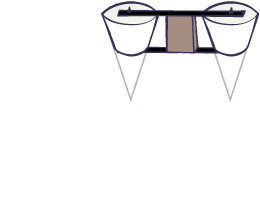
Click pic to play animation
Bet your bike doesn’t turn like that either. Still, cones lashed together with a frame are still eager to turn their own way, they are cones after all, stupid and stubborn to the end. Something has to give. In the case of an imaginary two-coned bicycle the weak point is whatever tread part has the least traction. The Cones roll on the part with the most traction, the rest spinning and skidding along. If you do this long enough the taper wears away little by little, eventually becoming… a wheel. Happily, bikes come with wheels from the git-go, saving you a lot of time and bother. In the end, a bicycle with two cones and parallel axles travels in a straight line. It does not turn. This may disappoint the cones, but that’s life.
So, while a tilted wheel riding on its side may act like a stupid, stubborn cone and turn, a bicycle is not just a wheel. It’s two wheels and a frame. You can get a two-coned bicycle to turn if one of the axles is allowed a steering rotation. But then that’s tracking, isn’t it?
I build a model bicycle with cones in place of wheels. For the cones I use two cottage cheese containers filled with sand to give them weight for traction. I drill holes in the centers of each to insert an axle. When I roll one on its side it travels in a circle. It turns. Not terribly exciting to you and me, but a dream come true for a cone.
I nail together a frame of scrap wood with two side rails and a wood block in the middle. The axels are nails through holes in the side rails

I give the little contraption a push and it rolls quite well travelling about 8 feet… in a straight line. I push it back the other way. Same thing, no turning. I take the wheel/cones off and flip them around in various configurations. I try rolling it while pushing down on the center block for more traction. But the result is always the same: straight line, no turn.
The cone turning effect fails utterly.
In a nutshell: a spinning wheel is a gyroscope and when tilted imparts torque on the axel causing a rotation somewhere somehow, so the wheel turns when you tilt it, and you can use this to turn a bike, maybe. Anyway, you’ve seen gyroscopes and they do amazing things. Why not use one to turn a bike? After all, a gyroscope has one wheel and a bike has two. Twice as good, right?
For the same reasons cones don’t turn your bike neither will gyroscopes. So just reread the bit above about cones and where it says “cones” put in “gyroscopic wheels” and there you go. The torque on an axle from a cone is analogous to the torque from a gyroscope, and it encounters the same problem, the constraining frame and the wheels tracking on the ground. Not satisfied? Want a semi-comprehensible explanation of gyroscopic wheels and all that? Soldier on. If you’re willing to concede skip down to “TRACKING PART THE SECOND — How the tilt changes the turn” below.
Here’s all you need to know, at least it better be because it’s all I know. Gyroscopic precession is a sort-of scientific voodoo that even the experts don’t really understand. Otherwise they could explain it better without having to invoke the mystical terms, angular momentum, torque, and precession. The latter of which means something like, “what comes around goes around.”
Many of us have played with spinning bicycle wheels in our hands to see the gyroscopic effect and it feels pretty strong. But that’s from turning it at the center of rotation and not pivoting it from the bottom, which is how a bike does it. At any rate, the axis of tilt rotation of a wheel rolling on the ground is at the contact patch and not the center of the wheel. This makes a difference. The torque gets all confused and doesn’t know which way to turn. By the time it figures it out it’s lost a lot of its strength. If you don’t believe me (who could blame you, after all, who am I?) there is a way to demonstrate this. Read “Dances with gyroscopes” below.
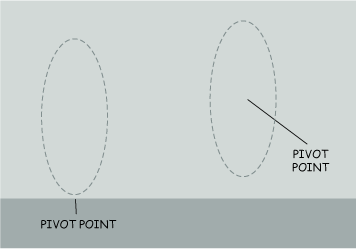


Mouseover pic to compare
The impact of a gyroscope depends on its weight and speed just like a boxer’s punch. A slow tap on the shoulder from a featherweight can get your attention, but a swift uppercut to the jaw from a heavyweight will put you on queer street. A bicycle wheel is a stringbean compared to you sitting there in the full flower of manhood on the beefy frame. And the wheels don’t spin all that fast unless you’re some kind of Lance Armstrong or something. This means the torque on a bicycle wheel axle is so weak it struggles to turn a training wheel let alone a big, old bike wheel with your muscular arms wrenching at the handlebars. And so what if your training wheels turn, it’s no big deal. If you ride a bike with training wheels you’re not tilting enough to worry about gyroscopes. But wear a helmet anyway, you never know when a gyroscope will store up a lot of torque and spring it on you suddenly.
The question is not how wheels behave because they’re gyroscopes, but how gyroscopes behave when they’re wheels. A wheel rolling on the ground tilts over at the contact patch and not the center of the wheel. This different motion means the rotational torque is weaker in comparison.
I did comparative measurements of the torque generated by each using a fisherman’s spring scale. The method was crude, but the comparison shows the rough difference. I built a device to hold a wheel upright as shown. When I tilted the rig to any angle with the wheel spinning as fast as I could muster by hand, the pull I got with the tilt axis at the center of the wheel was between 6 and 8 pounds. When I did the same with the tilt axis at the bottom of the wheel the pull was 2 to 3 pounds.

All that aside, when you tilt your bike you will get some gyroscopic torque, which has no effect to turn the bike. The problem, of course, is that you can’t rotate one object on two axes at once. A bike has two wheels on the ground to turn on, unless you’re pulling a wheelie.
I build a framework to hold two wheels in a bicycle configuration without a steerable front end as shown. I suppose I could have used the bike itself, but this was easier even though it was more work, if that makes sense. Placing it on a pivot point, a nail driven through a board held on my workbench, I spin the wheels. When I tilt the framework, it rotates, when rotated it tilts. Hooray! there’s precession.

However, a bike sits on two points, the contact patches of both wheels, not one. Placing the framework on two nails, one under each wheel, I spin the wheels and tilt it, it doesn’t rotate. Keep in mind turning (precession) is the effect, torque is the cause. Ever apply torque with a wrench to tighten a fully tightened bolt? It doesn’t turn, does it? If rotational torque is resisted by a stronger force the energy is dissipated as heat. I think that’s why you get hot under the collar trying to loosen rusty nuts that just won’t budge.
When a wheel turns it puts a torque on the axle, if held in a frame this torque is imparted to the frame. This torque can be reproduced with a lever, that’s what handlebars are. I nail a crossbar in the center of my framework as shown. By putting a rotational torque on the crossbar I can simulate what the gyroscopic effect would do at speed.

Walking alongside, I tilt the simulated bike and apply my simulated gyroscopic torque. It doesn’t turn. No matter how I tilt it or how much torque I apply it won’t turn with two wheels on the ground in alignment. Even though the torque I get from my lever is many times more than the gyroscopic effect, it is impossible to turn the bike this way.
On the other hand, let’s say a gyroscoping bike wheel finds the torque energy to turn your front axle. Should this happen it takes the front end assembly with it, they like travelling together. And good thing or you wouldn’t be able to steer otherwise. So the gyroscopic torque rotates the front end assembly and your bike turns. However, that’s tracking again, isn’t it?
Secure the front end of your bicycle so the front wheel assembly can’t rotate. You can do this with wires wrapped around the handlebars and seat post, with crazy glue, or a spot weld, but the wires are easier to get off. Get your bike rolling, give it a good shove and let it go. As soon as it tilts about 10 degrees it will flop to the ground without turning a bit. Do this on soft ground, no point in ruining your bike even in the name of science. No matter how fast it goes or how much it tilts it won’t turn unless the front wheel assembly rotates.
If you want to see some proof that tilting a bike won’t turn it without going through a lot of bother, watch the Tour de France. At the end of the sprint stages there will be a mad dash to the finish by the sprinters. Notice how the bikes flip-flop back and forth under the rider as they peddle furiously for the finish line. Notice they go straight all the while. As long as they hold the handlebars in a straight ahead position, they don’t turn a bit.
Some people believe they don’t rotate their handlebars in a highly tilted turn. People believe in lots of silly stuff: astrology, outlandish conspiracies, the birthday fallacy, politicians. One thing about this notion is what I would call a problem of perception, or misperception if there is such a word. What seems like a tight turn at high speed is a very leisurely turn at slow speed and needs little steering of the front wheel. What is a sharp turn at low speed is impossible or a death wish at high speed.
And by the way, a tilted bicycle tracks differently than an upright bicycle.
I stand my bicycle on the kickstand, I put a block of wood under that so it stands nearly straight up, like a well-behaved bike. I clamp the brakes closed so the wheels can’t spin or bolt for the exit to avoid being exposed for the tricksters they are. I draw a line on the floor from the front to the back where the wheels touch the ground. I’ll call this the baseline, you call it what you want but it’ll confuse things later on if you do. The amount the handlebars are rotated I’ll call the steer angle. The angle of the front wheel on the ground I’ll call the turn angle. The floor I’ll call “the floor.”

I rotate the front wheel 30 degrees and lash it in place with wires, opting not to go the crazy glue or welding route. This effectively holds the steer angle. With the bike upright I take measurements of the front wheel on the floor. The turn angle is also 30 degrees. I then take the same measurements with my bicycle tilted 45 degrees propped up with a piece of wood. The steer angle is still 30 degrees, but I find the turn angle is now 45 degrees. It wasn’t hard to find, it was right there on the floor. This means a tilted bicycle turns sharper than an upright bicycle. See, I told you wheels were tricky.

As you rotate the front end and tilt, the contact patch position varies relative to the steering axis. To show this, I take my bike with the front end secured at a 30 degree rotation. With the bike upright I mark the tire where it contacts the ground. Tilting the bike 45 degrees I see the contact patch is about 6 inches further forward compared to its upright position.
This happens because a steering rotation reorients the front wheel to the rest of the bike, the front axes are no longer the same as the rear axes. So rolling the rear end will pitch the front end.

For an extreme example just look at a bike with the front wheel turned 90 degrees. In this case roll for the rear is pitch for the front. At other rotations roll for the rear is partly pitch and partly roll for the front. Bike geometry is just funny that way as rearranging the bits reorients their axes to each other. The upshot is when you tilt the bike the front end pitches forward and so the front contact patch is further forward altering the turn angle.
To show what this means in practice I take my bicycle with the handlebars secured rotated 30 degrees. With the bicycle tilted 45 degrees I attach a plumb bob to the frame that just touches the ground. You can also use a plumb tom or a plumb sally, but mine is a bob. This allows me to keep my bicycle at a fairly consistent tilt. I mark the starting position, push my bicycle upright around in a half turn. The rear wheel of the bicycle travelled in about a 140 inch diameter circle. I rinse and repeat the procedure with the bicycle tilted 45 degrees. This turn diameter is about 110 inches.

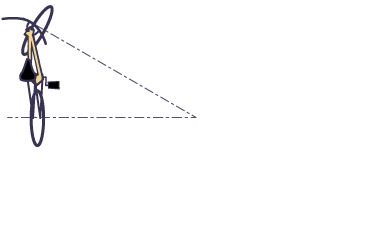
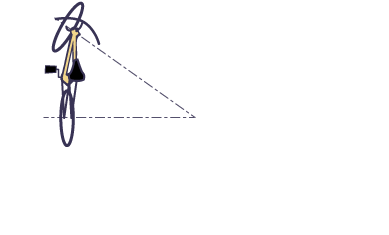
Click pic to play animation
Same bicycle, same steer angle, same travelling speed, different tilt, different turning diameter. That means the tilted bike’s turn diameter is… um, 110 divided by 140 times pi minus… is smaller. The upright bike looks slower in the animation, but it has farther to go.
There’s another way to look at this, if you like. Or even if you don’t I’m tossing it in anyway. Remember from above how where the axes of the wheels cross describes the center of the turning circle. Tilting your bike moves this intersection closer to the bike somewhere underground. Since the axles are not as long as the axes there’s no problem of scraping the ground and upsetting everything. This makes a smaller circle, thus a tighter turn. This explanation is simpler, but I thought you might like to know the details first.

The more you lean the more the turn angle increases at the same steer angle. For instance, leaning 60 degrees, as motorcycle racers often do, turns a five degree steer angle into a 15 degree turn angle. This is why it often appears as though superbike racers are barely turning their front wheels. Actually they are rotating the front end very little because… well, I just explained all that.
A bicycle does not turn by cone or gyroscopic effects without rotating the front end assembly. At least not while travelling on the ground which is the way most of us ride a bike. A tilting bicycle turns sharper than an upright bicycle. So, even though the cone and gyroscopic forces are there, it’s the much more powerful tracking forces that turn a bike.

So, if you’re heading straight for that chasm at the end of our flat level surface and the handlebars get stuck, jump off. Or maybe just use the brakes. Whatever you decide, don’t try to turn the bike with cones or gyroscoping wheels because it ain’t going to work unless the front wheel turns somehow, some way. Should you try it, you’ll have lots of time laying in your hospital bed figuring out what went wrong, even though I just explained it all to you.
Thankfully, when riding a bike we don’t have to know all the particulars. Otherwise the expression, “it’s like riding a bicycle” would have an entirely different meaning. If at this point you are still unconvinced I invite you to try these experiments for yourself. Or build a bicycle without a steerable wheel and try riding it. If you don’t kill yourself get back to me.
© Terry Colon, 2008
While leaning won’t turn a bike, turning a bike makes it lean. Go ahead and read Counter-Steering Made Easy-Peasy